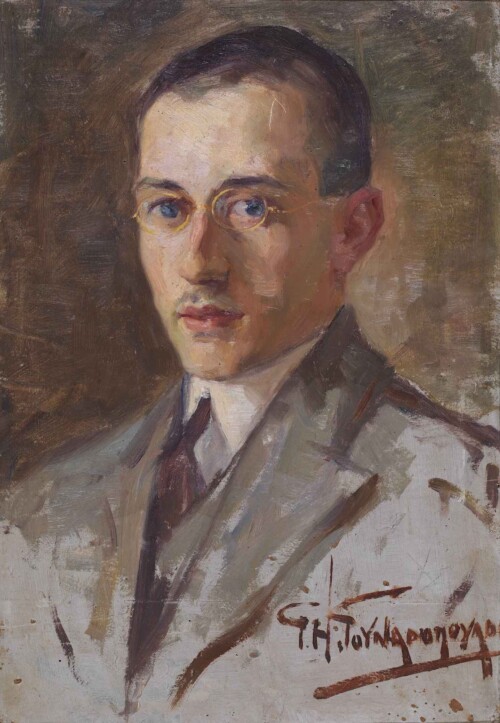| 22 |
Greek, 1889-1977
Portrait of Alexandros Papanastasiou
oil on hardboard
signed lower right
circa 1912-1919
46.7 x 31.5 cm
PROVENANCE
private collection, Athens
| sold for 1,767.75 € |
Portrait of Alexandros Papanastasiou
Alexandros Papanastasiou served twice as prime minister of Greece in the interwar period. He was born in 1876 in Tripoli; his father Panagiotis Papanastasiou was a member of the Greek parliament.
Between 1895 and 1898 he studied law at the National and Kapodistrian University of Athens earning his doctorate a year later. From 1901 to 1905 he furthered his studies in social science, law and philosophy at the Friedrich Wilhelm University in Berlin and Heidelberg. He continued his studies in London and Paris until 1907 when he finally returned to Greece.
In 1910 he was elected for the first time in the Greek parliament. He fought for the agrarian reform in Thessaly seeking to break up the big farms that existed there since the Ottoman rule and redistribute them to the local farmers.
In 1916 he joined the provisional Government of National Defence of Eleftherios Venizelos which sought to bring Greece at the side of the Allies of World War I. He was rewarded with the governorship of the Ionian Islands.
After World War I, Papanastasiou participated in several Venizelos governments as Minister of Transportation, Minister of National Health and Interior Minister. After Venizelos lost the 1920 elections, Papanastasiou criticised the subsequent Greek governments on the mishandling of the ongoing Greco-Turkish War of 1919-1922.
He was one of the politicians that published the Republican Manifesto which criticised the monarchy, stating that Greece was ‘the creation of the spirit, labour and struggles of her children. It is not the property of royalty and no part of Greece can be sacrificed for the sake of personal interests of her monarch’. For the publication of this manifesto, Papanastasiou was imprisoned along with other signatories.
When the People’s Party government collapsed, following the Asia Minor Disaster, Papanastasiou formed a government which at his insistence, on the 25th of March 1924, proclaimed Greece a Republic. The issue was submitted to a referendum with the voters approving the abolition of the monarchy on the 13th of April 1924.
From 1926 until 1928, he held the position of Minister of Agriculture and was instrumental in the establishment of the Agricultural Bank of Greece.
Papanastasiou briefly served as Prime Minister once more, between May and June 1932. In 1936 he was placed under house arrest by the government of Ioannis Metaxas. Later in the same year, he died of a heart attack.
Georgios Gounaropoulos studied at the School of Fine Arts Athens from 1907 till 1912 under Spyridon Vicatos, Georgios Roilos and Vikentios Boccheciampe.
After fighting in the Balkan Wars, in 1917, he won the Averoff prize along with a scholarship, and two years later he moved to Paris to continue his studies first at the Académie Julian (until 1924) and then at the Académie de la Grande Chaumière (until 1925).
During this period, his works were exhibited at the important Parisian salons. He is one of the few Greek artists who has been signed to Parisian galleries, firstly with ‘Vavin-Raspall’ and later with ‘Georges Bernheim’.
In 1932, due to the worldwide financial crisis, he returned permanently to Greece.
Gounaropoulos’ work progressed through three stages: from 1912 until 1919 in the academic style he was taught during his studies in Greece; the time he moved to Paris he discovered impressionism and was greatly influenced by the work of Paul Cezanne; between 1923 and 1924 he went through an intermediate stage where he developed a strong line drawing language that bordered with German expressionism.
From 1925 onwards he developed a more personal, surrealistic style, one where his subject matter (mainly female and male figures, floral themes, and still life) dominate a dreamy atmosphere. His play on shade and light has a central role in his work as well as his passion for poetic and symbolic ideas - a ‘cosmic painting' as he used to call it.
Between 1937 and 1939 he worked on the fresco decoration of the Municipal Hall of Athens committee room. The project is considered one of the most impressive of its kind in Greece to this day.
Gounaropoulos held many solo exhibitions in Athens and participated in several prestigious group exhibitions such as at the Salon Nationale des Beaux-Arts Paris, the Salon d'Automne Paris, the Salon des Indépendants Paris, the 1959 Sao Paolo Biennale and the 1963 Alexandria Biennale.
After his death, in 1977, his family donated his house to the Municipality of Zografou, which since operates as the Gounaropoulos Museum, housing personal objects and works by this great artist.
His work is found in many public and private collections, notably: The National Gallery of Greece, the Athens Municipal Gallery, the National Bank of Greece, the Averoff Gallery and the Leventis Gallery.
